In reply to Sidewayze :
Now THAT'S a good looking photo.
I may have gotten overexcited and bought an old Tyco locomotive. Seems they're not too reliable and not easily upgraded. Whoops. Maybe it will work for at least a little while on the small circle of track I have coming.
I already want to switch to DCC though. Lol. Maybe in 6 months.
In reply to ShawnG :
CP has 4 units painted in the old grey and maroon with script lettering, and four in the grey and maroon with block lettering
adam525i (Forum Supporter) said:When I see a picture of a GE spitting flames all I can think of are the 47 dead in Lac-Mégantic and the heart of their town that was wiped away. I've spent some time there with work and there is an eerie feeling in town, you can just tell something bad happened and that something is missing and hanging over everything. I can't imagine having that happen in a town I grew up in or trying to move past that, it will define that place from now on. It obviously wasn't the locomotives fault but a E36 M3 operator with lots of small things leading to a terrible tragedy.
Its almost impressive that they managed to bypass just about every safety system and procedure. If even one of those systems had been operational or procedures followed, then the whole tragedy could have been prevented or at the very least minimized. And really, JB Welding the turbocharger and manifold? Come on.
In reply to NickD :
This is why nothing is ever idiot proof. Some dipE36 M3 with oatmeal for brains will find a way, they always do.
In reply to NickD :
Having just read that Wiki article, my question is this:
Why was the locomotive with the bad turbo, which was already having mechanical issues and showing signs of being a fire hazard, the only one of the 5 left running? Seems to me that that's the one you would have shut off, and left one of the good ones idling for the compressor.
In reply to Recon1342 :
I do have to shake my head at this whole push for PTC. Railroads are spending hundreds of millions of dollars getting their lines and locomotives equipped and its been a real hassle, and a nightmare for anyone with older equipment or who wants to do mainline excursions, and I believe that experts said that it is supposed to reduce the amount of deaths from accidents by 7 and injuries by 22. That's a pretty poor return on investment. And that's guaranteeing it works right. It's all computerized and we know how reliable they are. Plus, no two systems are the same and some are incompatible, so you could have an instance where BNSF equipment is running over CSX rails and the CSX system won't see the BNSF locomotives. And people have proven time and time again that they can, and will, circumvent safety measures. Especially because Precision Scheduled Railroading is in effect and one late train snarls the whole system up worse than ever, so crews, if given the choice between being late or running without safety gear operating, will likely choose to keep the train on time.
In reply to Duke :
Hard to say. Since it was the lead unit, it was perhaps easier to shut the others down and leave it running, rather than shutting that one off and isolating it and going back to leave another running. Again, its a case of, if they hadn't disabled or ignored other safety systems in place, there wouldn't have been an issue. If they had gone and set handbrakes on 9-15 of the cars, even if the locomotive had failed, the train wouldn't have rolled away.
From what I've read, Fairbanks-Morses were notorious for big exhaust fires. Up on the Canadian Pacific, they said when they were starting to wear out, they would idle for long periods of time in the cold temperatures and some of the cylinders would stop firing properly. Then because of the odd supercharged 2-stroke vertical opposed-piston design, the fuel from the upper cylinders would run down into the exhaust manifold and when they finally needed to use it, they would throttle up the engine and it would light off all cylinders and shoot 4-6 foot pillars of flames out of the exhaust.


Also, lots of stories of cranking them for extended periods of time and then when they light off, they would make a US Navy destroyer level smokescreen with some fireballs mixed in. As well as, when they got old and the seals started leaking, they would suck oil and carbon up the exhaust pipes. Then you'd crank the throttle and they'd blow baseball-sized chunks of flaming carbon into the air and rain it down on you and the surrounding area.
An account of this exciting occurrence:
"Three of the U S Army H12-44s appeared at the Military Ocean Terminal Sunny Point (MOTSU) in the mid 1980s, long after FM diesel locomotives had just about disappeared from most railroad operations. I was a locomotive engineer in the U S Army Reserve 1205th Railway Services Unit and was introduced to the new arrivals during our 2 week annual training visit. The locomotives were 1852, 1858 and 1860. Not sure where they had been before MOTSU, but I now know two spent some time in Colorado. 1858 went out of service and later disappeared - c. 1988. 1852 and 1860 continued in service and when I went on active duty at MOTSU Nov 1990-Dec 1991 I really got to know and like the FMs once I got used to the rather unique reverser/throttle combination. The cabs, controls and gauges were well laid out and could easily accommodate a 5-person crew. Other locomotives there at the time included EMD MRS1s, a pair of GP7Ls (I disliked these locos! But they are preserved at the Florida RR Museum), and GP10s. The FMs were assigned top the same tasks as the others despite the horsepower difference (FM 1200 hp, others 1500-1800 hp.) MOTSU cargo was largely class A and B explosives so fire protection was important. My greatest excitement was a stack fire that began when I was hauling about 20 loads of ammo. Once the flaming chunks started falling I had the crew quickly cut us off of the cars and get to a grade crossing to be met by the base fire department. They had us sit tight until the fire burned itself out and said we would be OK after that - so we went back to work without further incident. "
Yeah, having chunks of flaming carbon rain down on car loads of explosives had to hike the old heart rate. Its also interesting that the military was still using MRS1s and FMs as late as the '80s and '90s. The EMD MRS1s were 35-40 years old at the time and Fairbanks-Morse had been out of the locomotive business entirely for almost just as long.

There are also accounts of them, after the seals got really bad, having engine runaways that destroyed engines. And they were prone to overheating. Plus they were wildly complex compared to any of their competition.
Wabash's solution to the general funkiness of F-M engines was they sent their 8 H24-66 "Train Masters" off to Alco and had the big 2400hp opposed-piston engines replaced with 2400hp Alco 251s.
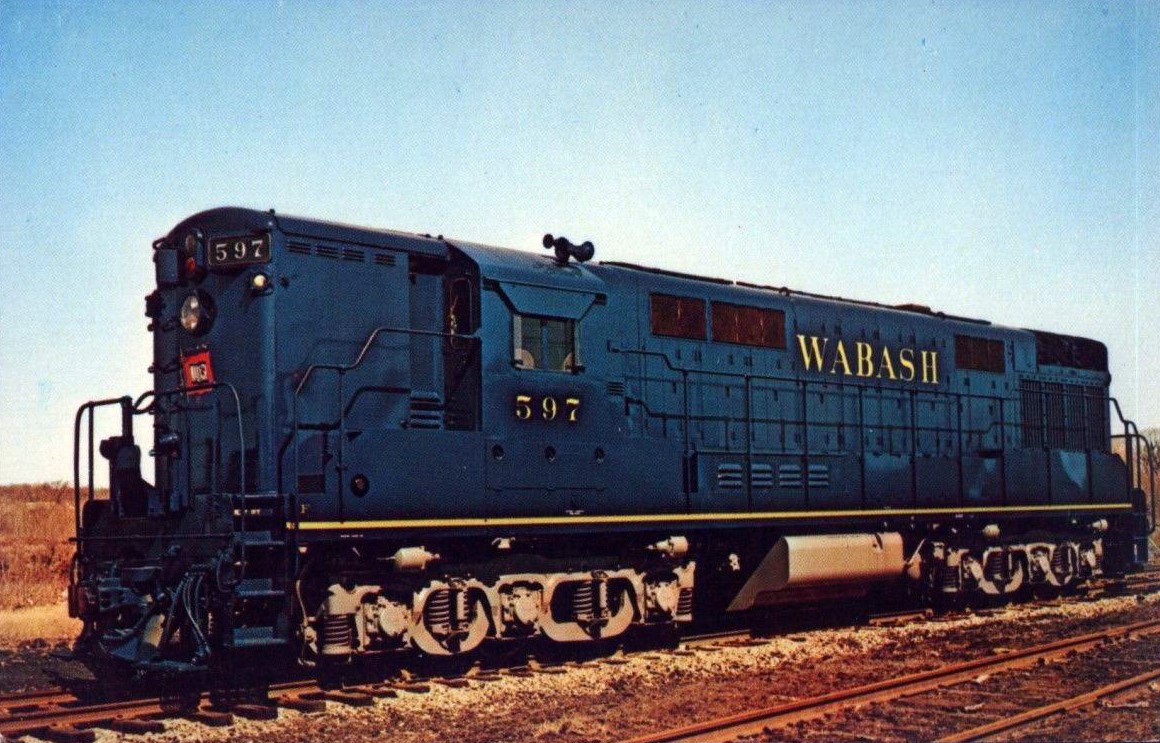
Here is the same unit, #597, after being renumbered to #557. It is also hooked up to a Nickel Plate GP9. Why is a Wabash unit hooked up to an NKP unit? Simple, Norfolk & Western had just taken over the two lines

A pair of the Alco-repowered Train Masters being looked over, shortly after the N&W takeover. #594 would end up being cut down into a yard slug, as were many of the Train Masters that N&W acquired through its takeover of Virginian.


N&W #3599, a few years before retirement. The Wabash lettering is becoming visible again from paint fade. This was originally TM-2, the second of four Train Master demonstrators that toured railroads trying to drum up interest. Wabash ended up with 2 of the 4 and Southern Pacific ended up with the other 2.

Speaking of TrainMaster, The Lionel Virginian Fairbanks-Morse Trainmaster No. 2331 would be available from 1955 until 1958. The lettering on this engine is rubber-stamped and it is the only one of this type of diesel that Lionel did not put their production number on the sides.
This diesel was equipped with Magnetraction, exterior lights at both ends, dual vertical worm drive motors, horn, three position directional unit that is adjustable from the bottom, and operating disc couplers at both ends. The dual motor bogeys and the weight of the locomotive made it a favorite for its pulling capacity. The flanges on the wheels on the inner axles are missing. This is so that this engine could negotiate the tight radius of Lionel’s O Gauge track. This engine will not operate on O27 Gauge track.
In reply to Appleseed :
Interesting parallels in that the Train Master was also short-lived and loved by owners for its pulling power. Virginians, which was a heavy coal hauler and owned strictly F-M diesels except for a single GE 44-Tonner, loved their Train Masters and smaller H16-44
I think I have a name for my layout. I'm gonna call it The Full Circle Railroad. Not because I bought just enough track pieces to make a small circle, but because like all my other hobbies, this one has come full circle, so to speak. What I mean is, as a kid, we had a small train set we put up at Christmas. I liked it but mostly because of the auto transporter car. My interest in trains was always fueled more by the scenery and the tiny automobiles around the layout. I would get the catalogs and look through them to see what Fords they had. After a while I moved on to other hobbies, and we didn't really get the track out for Christmas anymore. Now, years later, I've gathered a small collection of 1/87 scale cars for various reasons: because they work as board game pieces, because they're a model of a car I once had, or because they're neat. And now this forum has reminded me how much I like the scenery around a model railroad layout. The cars, but also the buildings and scenes. It can hold any sort of situation you can dream up. And thus, things have come full circle.
And also because I bought just enough track pieces to make a small circle. ![]()
Because we're big on enabling around here, pretty sure you're gonna need this Walthers item sometime soon:

Virginian Railway: The Richest Little Railroad In The World.
And also home to some of the largest, most outrageous steam engines. Most notable was their Class AE 2-10-10-2 Malletts. Their overall width of 144" was so wide that they had to be delivered without the front low-pressure cylinders and their cabs so that they didn't have clearance issues in transit. Their 48"x32" diameter low-pressure were the largest on any steam locomotive and had to be inclined several degrees to clear the ground. The 30"x32" rear cylinders were no slouches either. The boiler had a 112 7⁄8 inch diameter at its largest course, also a world record. By using such a large diameter boiler, the engines were actually able to maintain a steady steam supply and pressure while being operated at their limits, unlike the Erie Triplexes and Santa Fe 2-10-10-2s, which had suffered from essentially running out of breath in short order while being worked hard. The tender is incongruously small for a simple reason: due to the length of the engine, if they had used a longer tender, the engine would not have fit Virginian's roundhouses or turntables. Their 176,600lbs of tractive effort was enormous for the era (1918) and the Class AE was the ultimate coal drag engine of it's time. The 10 of them would remain in service until 1949, rarely being photographed for some reason, before being cut up. It is rumored that along with several other examples of Virginian large steam engines, a Class AE was set aside for preservation and then cut up around 1958 by new company management who was not so sentimental, resulting in an 0-8-0 being the only preserved Virginian steam engine.

Virginian's Class AG 2-6-6-6s were a direct copy of the C&O's H-8 Alleghenys, one of the best fast freight locomotives ever constructed (although C&O and Virginian both stuck them in drag freight). Instead of calling them an Allegheny, Virginian named theirs "Blue Ridges".

The H-8s/AGs were certainly fearsome looking, with a face full of air pumps and those huge steam pipes running to the cylinders, plus that 3-axle trailing truck, unseen on any other locomotive produced in large numbers.
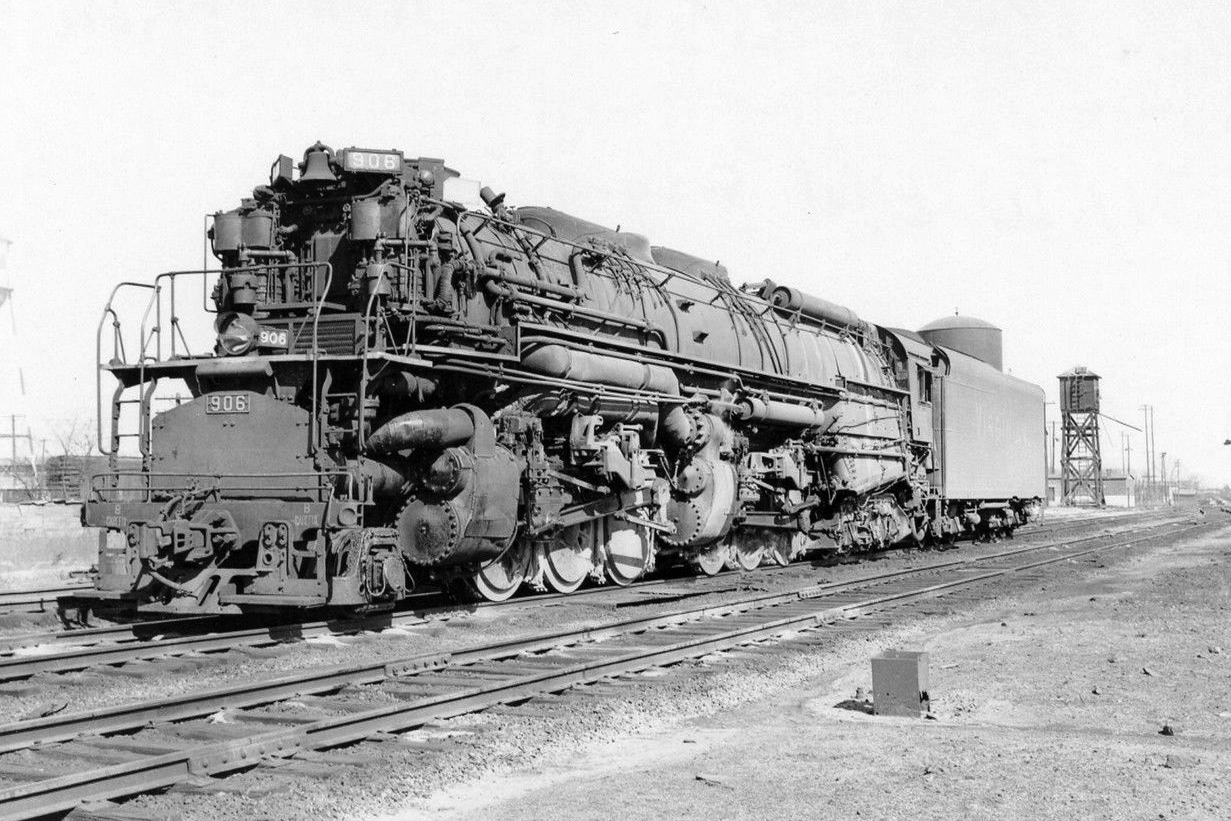
Another case of Virginian preferring competitor C&O's designs, Virginian would purchase 5 Class BA Berkshires from Lima, which were identical to C&O's famed Kanawhas. On a detour move over the N&W, a Virginian BA was reported to have hit 87mph while pulling a 3500 ton train, a testament to the Lima design. With 12 C&O Kanawhas in existence, it'd be nice to see one painted up as a Virginian BA. Who knows, C&O #2716 has been disguised as a never-was Southern engine and as a L&N Big Emma, so maybe one day she'll wear the Virginian lettering
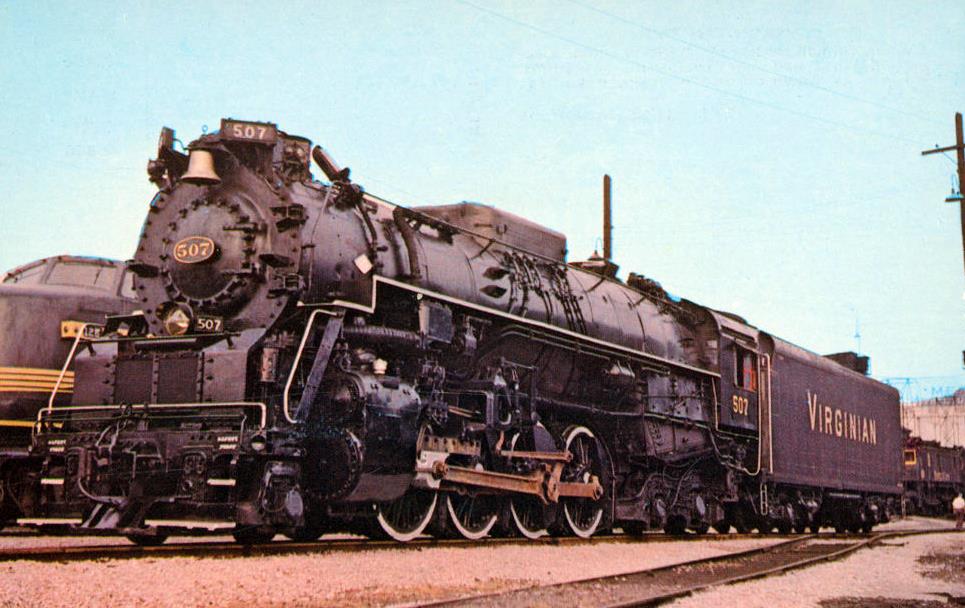
NickD said:The H-8s/AGs were certainly fearsome looking, with a face full of air pumps and those huge steam pipes running to the cylinders, plus that 3-axle trailing truck, unseen on any other locomotive produced in large numbers.
For some reason, I love front- mounted compressors on steam locomotives. GN ran multiple types that way, UP had a class of 4-8-2s, and of course there's the famed Allegheny class mentioned above. Dunno. Something about the way they look...
They also had massive compound 2-8-8-2s

A few short-drivered Pacifics for their cursory passenger service

And some tough-looking Mikados with 56" drivers, dual cross-compound air pumps under the running board (gotta watch those air brakes all on those mountain grades) and "clear-vision" tenders

Like the Erie, Virginian experimented with a single 2-8-8-8-4 Triplex. Like the Erie, Virginian found the concept lacking and cut it up into a 2-8-8-2 and a 2-8-2.

#410 here was the Mikado that was formerly the rear third of triplex #700, receiving Walschaerts valve gear in place of the original Baker valve gear in the process.

Recon1342 said:NickD said:The H-8s/AGs were certainly fearsome looking, with a face full of air pumps and those huge steam pipes running to the cylinders, plus that 3-axle trailing truck, unseen on any other locomotive produced in large numbers.
For some reason, I love front- mounted compressors on steam locomotives. GN ran multiple types that way, UP had a class of 4-8-2s, and of course there's the famed Allegheny class mentioned above. Dunno. Something about the way they look...
Of the Allegheny, David Page Morgan came face-to-face with #1624 at Clifton Forge in 1955 and wrote “She looked typically Chessie, subtly Lima — an awesome factory of concentrated energy. The 1624 was a plumber’s paradise: pumps on the nose, huge steam pipes coiling out from under to hug the running boards, air reservoirs atop the smokebox, a pair of enormous sandboxes. . . and yet, an orderly design notwithstanding.”
C&O put them on their heavy Pacifics as well, which was quite a look for a passenger engine, especially with the Vanderbilt tender. I like this one posed in front of General Motors. If only they knew...

The C&O's heavy Mikes also looked like bruisers.
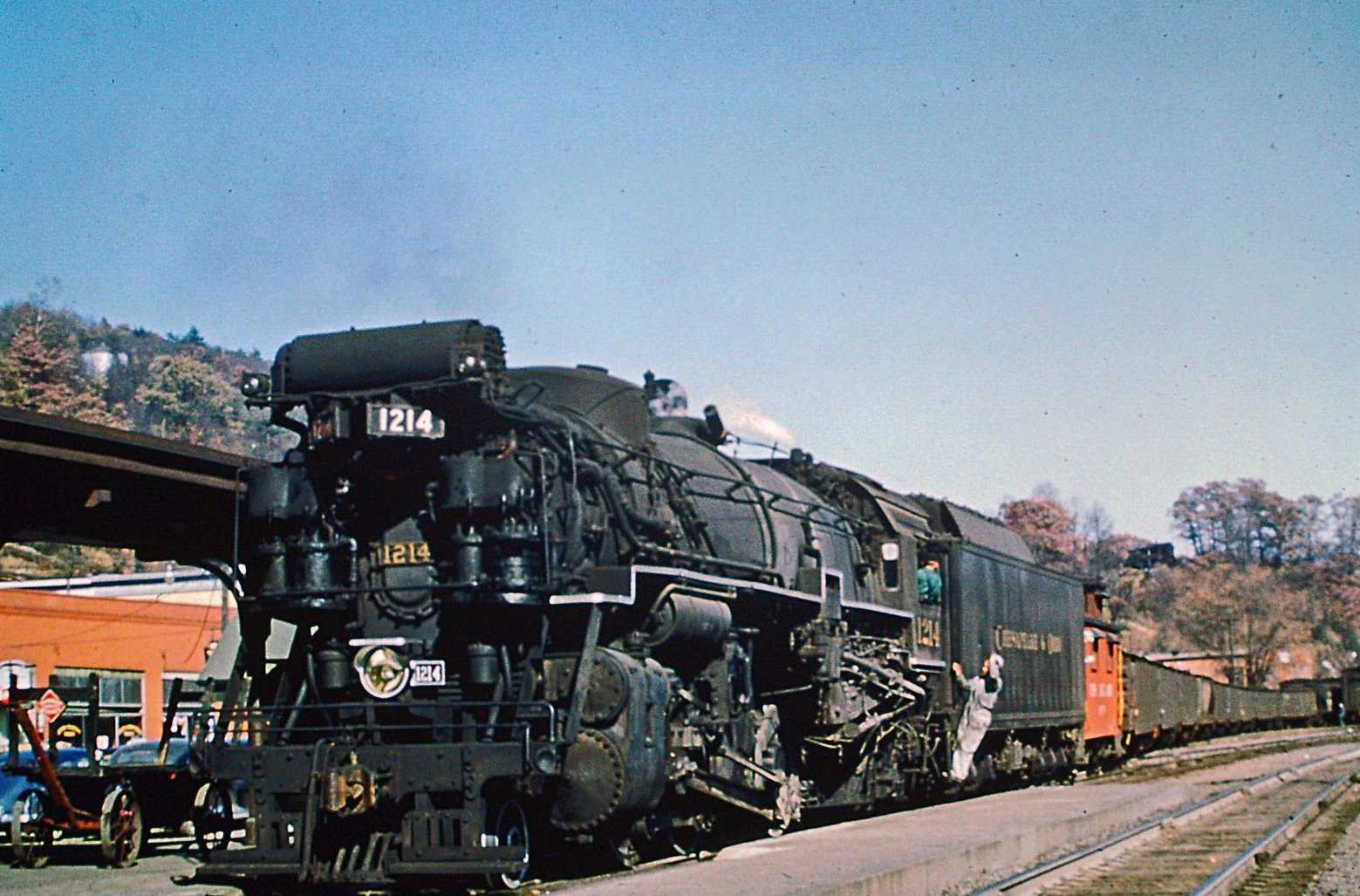 And then there was Union Pacific's #9000 series outrageous triple-cylinder 4-12-2 "Overlands". I've read many accounts of the unusual exhaust note of these engines, due to their 3-cylinder construction. Its frequently described as sounding like each exhaust blast was trying to beat the next one out of the stack.
And then there was Union Pacific's #9000 series outrageous triple-cylinder 4-12-2 "Overlands". I've read many accounts of the unusual exhaust note of these engines, due to their 3-cylinder construction. Its frequently described as sounding like each exhaust blast was trying to beat the next one out of the stack.
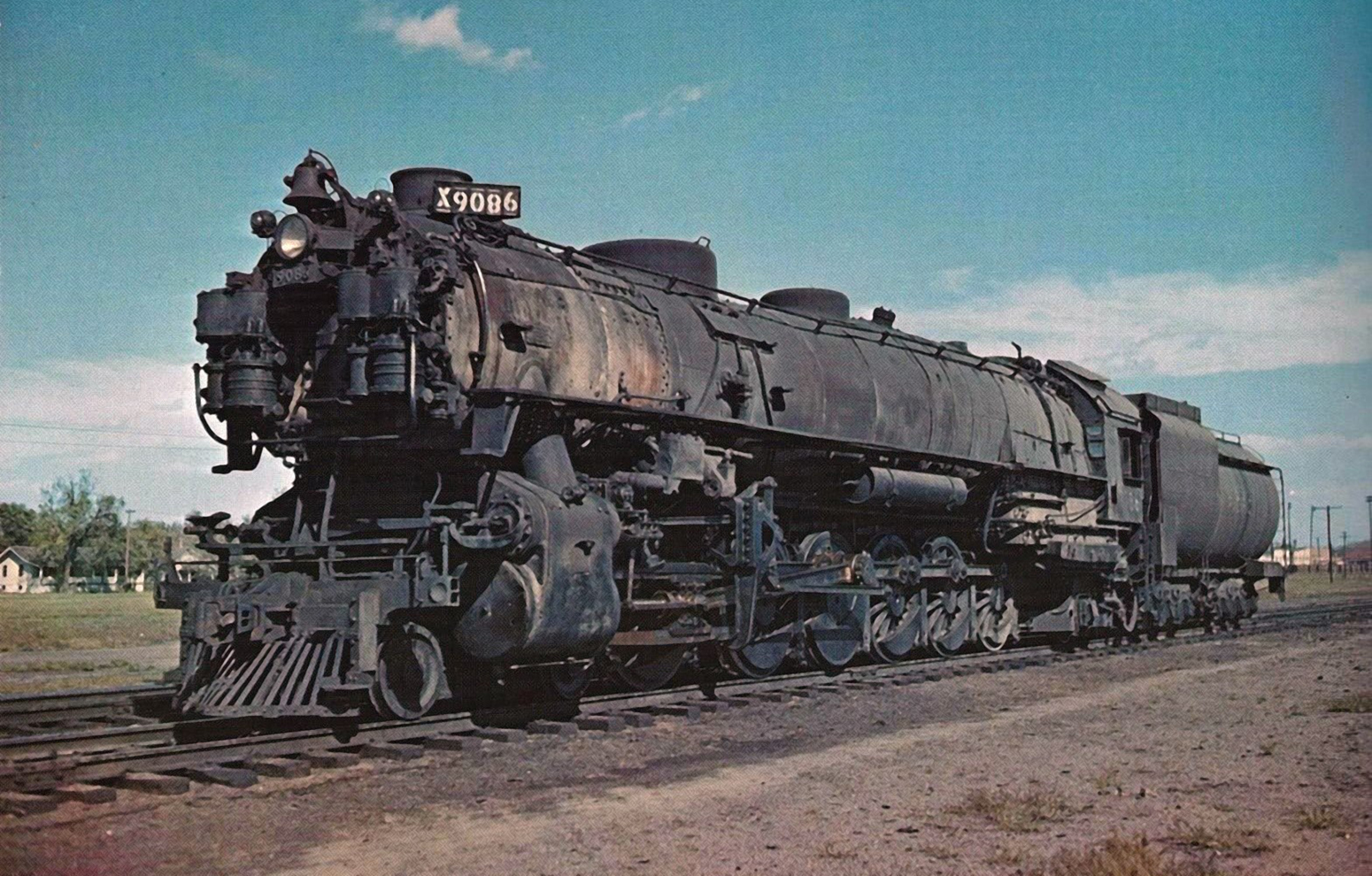
You'll need to log in to post.